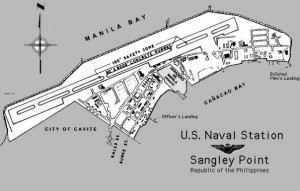European team studying Cavite airport project bullish on PH

A map of Sangley Point military facility, which used to be a US naval station. The local consortium All-Asia Resources and Reclamation Corp. plans to build on reclaimed land off Sangley Point an international airport and seaport. PHOTO FROM FACEBOOK.COM
MANILA, Philippines—Meget varme. Venlige. Imoedekommende.
They’re Danish for very warm, friendly and hospitable and they best describe Filipinos, according to Frantz Knudsen, project director of the Copenhagen-based airport and seaport engineering design and construction giant Ramboll Group A/S.
Knudsen and his team of European airport construction experts are in town working on the feasibility study of the country’s newest international airport and seaport that the local consortium All-Asia Resources and Reclamation Corp. (ARRC) plans to build on reclaimed land off Sangley Point, the former US naval station on the tip of the Cavite peninsula. They expect to wrap up work on the study in November.
“Fillippinere er meget varme, venlige og imoedekommende (Filipinos are very warm, friendly and hospitable),” the Danish national told the Inquirer as he noted the truth in the country’s tourism slogans, “It’s more fun in the Philippines” or “It’s more fun doing business in the Philippines.”
The Ramboll team also found personnel of over a dozen government agencies they consulted to be very professional.
Article continues after this advertisementKnudsen said consultative meetings were held with officials of several government agencies, including the Philippine Reclamation Authority, Department of Transportation and Communications, Department of Public Works and Highways, Department of Science and Technology, Department of Environment and Natural Resources, Department of Tourism, National Economic and Development Authority, Manila International Airport Authority, Philippine Ports Authority, as well as the Philippine Navy and Philippine Air Force .
Article continues after this advertisement“The conceptual plans that we submitted in our Letters of Intent to the DOTC and the PRA in January have been refined, based on our just concluded data-gathering activities and meetings with stakeholders,” Knudsen told the Inquirer.
Knudsen confirmed claims made by William Tieng, chair of the Solar Group, the lead local partner of ARRC, that the consortium’s foreign partners were bullish about the Philippines and its development prospects, particularly the development of the country’s newest international gateway.
“These foreign business entities have expressed in writing their firm commitment to participate in these modern and major job-generating projects,” Tieng said.
Phase 1 of the airport project calls for the reclamation of 50 hectares offshore of the PAF-operated Danilo Atienza Air Base with a budget of around P8 billion, and the construction of a 200-million-liter bulk liquid port, estimated to cost P10.8 billion.
It also calls for the development of a 50-million-a-year airport terminal and the first of two runway systems, estimated to cost P56.2 billion and P45 billion, respectively.
“The development of the modern passenger terminal is demand-driven based on the current 31-million annual passenger traffic at the Ninoy Aquino International Airport, the capacity of which is constrained by limited space,” said the ARRC proposal.
The project will also require the development of a connecting road network, as well as a snake-shaped, cable-stayed bridge that would connect the airport to Boulevard 2000.
Construction of Phase 1 is estimated to run from 2014 to 2018 (up to 2020), according to ARRC.